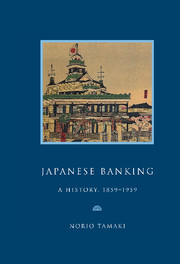Book contents
- Frontmatter
- Contents
- Preface
- Genealogy of leading Japanese banks, 1859–1959
- List of abbreviations
- Map
- Part I A bankrupt Shogunate, 1859–1868
- Part II The Meiji Restoration: monetary confusion and banking experiments, 1868–1881
- Part III Matsukata, the wizard of Japanese banking, 1881–1897; the Yokohama Specie Bank (1880) and the Bank of Japan (1882)
- Part IV The Japanese on the London money market, 1897–1911
- Part V War, the Japanese boom years, 1911–1919
- Part VI Crisis and the road to war, 1919–1937
- Part VII Complete commitment, struggle and defeat, 1937–1945
- Part VIII American ‘democratisation’ and the search for growth, 1945–1959
- Historical background
- 28 MacArthur's directives, 1945–1948
- 29 Remaking the banking system: the Japanese versus the Americans, 1946–1952
- 30 The rise of governmental banking and the search for stability: Japanese initiatives, 1949–1958
- 31 The post-war system, 1946–1959
- An extraordinary century, 1859–1959
- Appendices
- Notes
- Bibliography
- Index
31 - The post-war system, 1946–1959
Published online by Cambridge University Press: 03 February 2010
- Frontmatter
- Contents
- Preface
- Genealogy of leading Japanese banks, 1859–1959
- List of abbreviations
- Map
- Part I A bankrupt Shogunate, 1859–1868
- Part II The Meiji Restoration: monetary confusion and banking experiments, 1868–1881
- Part III Matsukata, the wizard of Japanese banking, 1881–1897; the Yokohama Specie Bank (1880) and the Bank of Japan (1882)
- Part IV The Japanese on the London money market, 1897–1911
- Part V War, the Japanese boom years, 1911–1919
- Part VI Crisis and the road to war, 1919–1937
- Part VII Complete commitment, struggle and defeat, 1937–1945
- Part VIII American ‘democratisation’ and the search for growth, 1945–1959
- Historical background
- 28 MacArthur's directives, 1945–1948
- 29 Remaking the banking system: the Japanese versus the Americans, 1946–1952
- 30 The rise of governmental banking and the search for stability: Japanese initiatives, 1949–1958
- 31 The post-war system, 1946–1959
- An extraordinary century, 1859–1959
- Appendices
- Notes
- Bibliography
- Index
Summary
Integration, 1946–1954
By the end of March 1948, under the Financial Institution Reconstruction Act of October 1946, the disastrous losses of all wartime bank advances were liquidated. The amount thus eliminated totalled ¥24,800 million, of which nearly two-thirds belonged to ordinary banking. A series of antitrust measures and enactments by the end of 1947, which dissolved the zaibatsu, nullified the bank agreements on interest rates. Urgent action was needed and, with the aid of advice from SCAP, the Temporary Rate Regulation Act was promulgated in December 1947. Under the Act, any rates of interest, from Bank of Japan Rates to call market and mutual loan rates, were to be subject to the directive of the Bank of Japan governor in consultation with a Rate Regulation Committee.
A comprehensive Financial Business Bill, together with a Financial Institution Accountancy Bill, proved, by the middle of 1949, to be abortive. They were overtaken by a surge of policy changes brought about by the Dodge Line. Before the breaking apart of the two bills, the Finance Ministry tried hard to put the system together and base it on a more sound foundation. In the autumn of 1946, the government started surveying and reviewing the branch network of banking and other financial institutions. By the spring of 1952, due to the designation of all offices, other than the head office, as ‘branches’, the number of branches increased by more than 1,000.
Looking at the American examples, the government had earlier, in the autumn of 1947, presented an outline of deposit insurance, which developed into the ‘Outlines for Deposit Insurance Act’ in October 1949.
- Type
- Chapter
- Information
- Japanese BankingA History, 1859–1959, pp. 202 - 206Publisher: Cambridge University PressPrint publication year: 1995



